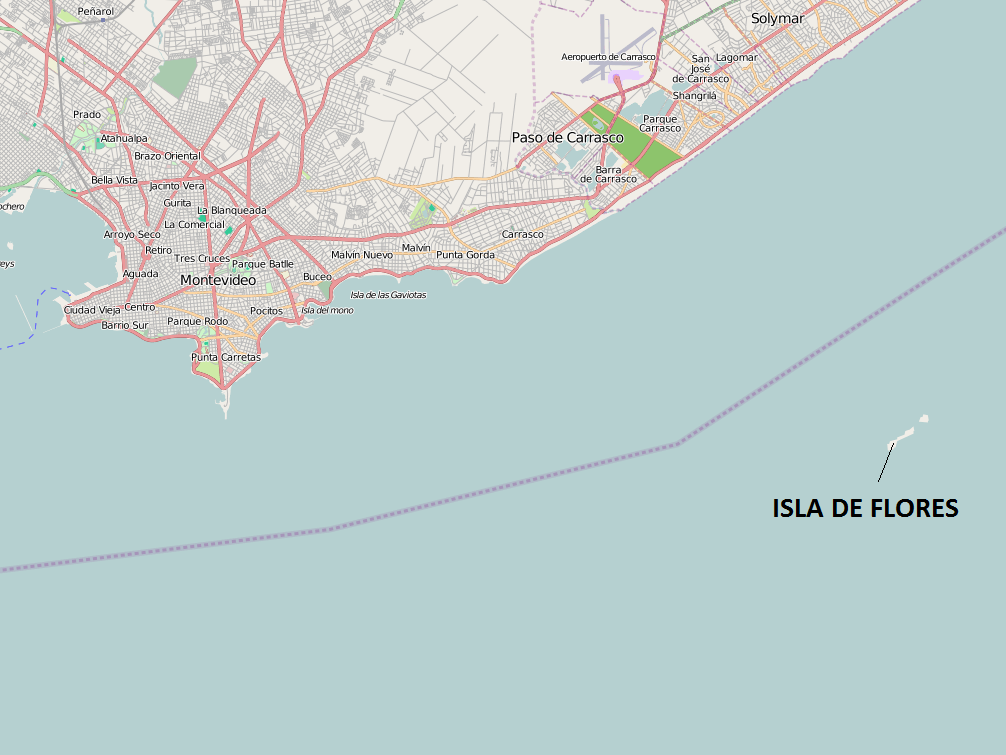Isla De Flores on:
[Wikipedia]
[Google]
[Amazon]
 Isla de Flores is a small Uruguayan island in the
Isla de Flores is a small Uruguayan island in the
 Isla de Flores is a small Uruguayan island in the
Isla de Flores is a small Uruguayan island in the Rio de la Plata
Rio or Río is the Portuguese, Spanish, Italian, and Maltese word for "river". When spoken on its own, the word often means Rio de Janeiro, a major city in Brazil.
Rio or Río may also refer to:
Geography Brazil
* Rio de Janeiro
* Rio do Sul, a ...
, south-east of Punta Carretas
Punta Carretas is a '' barrio'' (neighbourhood or district) of Montevideo, Uruguay.
Location
Punta Carretas shares borders with Parque Rodó and Pocitos to the north, while from east south and west, it is delimited by the coastline, including ...
, Montevideo, Uruguay
Uruguay (; ), officially the Oriental Republic of Uruguay ( es, República Oriental del Uruguay), is a country in South America. It shares borders with Argentina to its west and southwest and Brazil to its north and northeast; while bordering ...
. The island and 2 nautical miles of water around it were made a national park on February 26, 2018.
History
Flores was named by Sebastián Gaboto, who discovered it on Easter Sunday 1527 (the Spanish expression ''Pascua Florida'' or ''Pascua de Flores'', i.e. "Flowery Easter" was the reason for the name "Flores"). The island was visited occasionally by sailors. The British-born U.S. minister George Pegler recounts a short visit in about 1811 or 1812, along with the rest of the crew of the British Navy frigate ''Horatio''. The crew named it Seal Island for the vast numbers ofSouth American fur seal
The South American fur seal (''Arctocephalus australis'') breeds on the coasts of Peru, Chile, the Falkland Islands, Argentina, Uruguay and Brazil. The total population is around 250,000. However, population counts are sparse and outdated. Altho ...
s. Parties of 100 or more sailors would land on the island to hunt the seals.
Some were black, some brown, some yellow, some almost white, and others were spotted and streaked. Our custom was to land before daylight and imitate their barking, when they would invariably leave their lair where they had spent the night and make a rush for the water. We would form two lines and stand with club in hand, and as they attempted to pass we knocked them down. If the first or second happened to miss his aim some one else would be more fortunate, and before they could reach the water most of them would be dispatched. The next day we would find another path from the water to their den and obtain our game in a similar manner. Some mornings we killed more than one hundred. We took off their skins and saved the heart and liver for a fry. Every man on board had a good supply of skins, together with caps, waistcoats, trowsers, and jackets. The captain had a carpet made of different colors, for the cabin, in imitation of a lady's bed-quilt. I made myself a suit of outer garments, and picked up enough clippings of different colors to make my mother a carpet eight or ten feet square. I had the pleasure of seeing it yet in use more than twenty years after I sent it home.As well as the abundant fur seals, the 13-year-old Pegler also noted one horse and a sheep, and speculated that they had been left on the island by General
John Whitelocke
John Whitelocke (1757 – 23 October 1833) was a British Army officer.
Military career
Educated at Marlborough Grammar School and at Lewis Lochée's military academy in Chelsea, Whitelocke entered the army in 1778 and served in Jamaica and in S ...
when returning from the unsuccessful British attempt to capture Buenos Aires in 1807 (Pegler misdates this to 1805). Joshua Percy, captain of the ''Horatio'' and son of the Duke of Northumberland
Duke of Northumberland is a noble title that has been created three times in English and British history, twice in the Peerage of England and once in the Peerage of Great Britain. The current holder of this title is Ralph Percy, 12th Duke o ...
, succeeded in shooting the sheep on the crew's last day on the island.
Lighthouse
Isla de Flores has a historic lighthouse, which was the subject of an 1819 treaty, by which Uruguay lost theMisiones Orientales
The Misiones Orientales (, ) or Sete Povos das Missões/Siete Pueblos de las Misiones (, ) is a historic region in South America, in present-day Rio Grande do Sul, the southernmost State of Brazil.
Together with present-day Misiones Province ...
. This lighthouse, of Portuguese origin, entered service in 1828. It was dubbed "the world's most expensive lighthouse". The lighthouse is now under the jurisdiction of the Uruguayan Navy. It is tall and flashes twice every 10 seconds.
Accidents
On 6 June 2012, the Fairchild SA227AC Metro III CX-LAS of Air Class Airlines, performing a freight flight on behalf of DHL from Montevideo toBuenos Aires
Buenos Aires ( or ; ), officially the Autonomous City of Buenos Aires ( es, link=no, Ciudad Autónoma de Buenos Aires), is the capital and primate city of Argentina. The city is located on the western shore of the Río de la Plata, on South ...
disappeared south of the island of Flores.
Bibliography
*References
External links
{{Coord, 34, 56, 39.7, S, 55, 55, 52.1, W, type:landmark, display=title River islands of Uruguay Birdwatching sites in Uruguay Landforms of Montevideo Department Islands of the Río de la Plata National parks of Uruguay